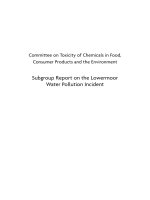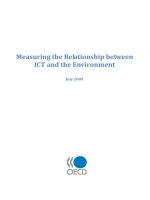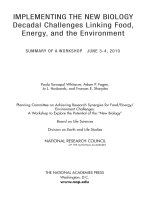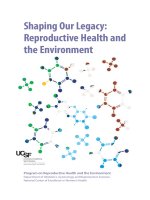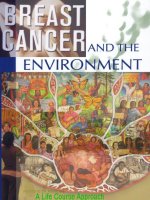Water and the Environment pptx
Bạn đang xem bản rút gọn của tài liệu. Xem và tải ngay bản đầy đủ của tài liệu tại đây (2.67 MB, 68 trang )
[Aristotle attributed this teaching to Thales of Miletus,
the first known Greek philosopher, scientist, and mathematician.
Thales lived from approximately 624-546 B.C.]
Publishing Partners
AGI gratefully acknowledges the
following organizations for their
support of this book and the poster,
Water — The Essential Resource.
A list of other titles in the AGI
Environmental Awareness Series
and information on ordering these
publications appears on page 2.
Bureau of Reclamation
National Park Service
U.S. Army Corps of Engineers
USDA Forest Service
U.S. Geological Survey
AGI Environmental Awareness Series, 5
Stephen J. Vandas
Thomas C. Winter
William A. Battaglin
With a Foreword by Philip E. LaMoreaux
American Geological Institute
in cooperation with
Bureau of Reclamation, National Park Service, U.S. Army Corps of Engineers,
USDA Forest Service, U.S. Geological Survey
2
About the Authors
Stephen J. Vandas, a hydrologist with the U.S. Geological Survey, received a B.S. in Watershed
Sciences from Colorado State University in 1975. He has also worked as a hydrologist for the U.S.
Bureau of Reclamation and the U.S. Bureau of Land Management. His work has included reservoir
operation and irrigation scheduling studies, environmental studies involving instream flow, wilderness
water rights, oil-shale development, and Colorado River Basin salinity. His most recent project has
been the development of water-education materials.
Thomas C. Winter, a Senior Research Hydrologist with the U.S. Geological Survey in Denver,
received B.A., M.S., and Ph.D. degrees in Geology from the University of Minnesota. In 2002, Winter
received the O.E. Meinzer Award, the highest honor in the field of hydrogeology in the nation, from the
Hydrogeology Division of the Geological Society of America. Following 12 years of conducting water
resources assessments in Minnesota, he has conducted research since 1973 on the hydrology of lakes
and wetlands, with emphasis on their relation to groundwater. He helped initiate and has been a
principal investigator at long-term field research sites in New Hampshire, Minnesota, North Dakota,
and Nebraska since the late 1970s.
William A. Battaglin received a B.A. in Geology from the University of Colorado, Boulder, in 1984,
and a M.E. in Geological Engineering, from Colorado School of Mines, in 1992. He has worked as
a hydrologist for the U. S. Geological Survey, Water Resources Division since 1985. He is currently
working on studies that use geographic information systems and statistics to investigate the fate and
transport of nutrients and agricultural chemicals in water resources of the midwestern United States.
American Geological Institute
4220 King Street
Alexandria, VA 22302
(703) 379-2480
www.agiweb.org
The American Geological Institute (AGI) is a nonprofit federation of 40 scientific and professional asso-
ciations that represent more than 120,000 geologists, geophysicists, and other Earth scientists. Founded
in 1948, AGI provides information services to geoscientists, serves as a voice of shared interests in the
profession, plays a major role in strengthening geoscience education, and strives to increase public
awareness of the vital role the geosciences play in mankind’s use of resources and interaction with the
environment. The Institute also provides a public-outreach web site, www.earthscienceworld.org.
To purchase additional copies of this book or receive an AGI publications catalog please contact
AGI by mail or telephone, send an e-mail request to , or visit the online bookstore at
www.agiweb.org/pubs.
Copyright 2002 by American Geological Institute
All rights reserved.
ISBN: 0-922152-63-2
Design: De Atley Design
Project Management: Julia A. Jackson, GeoWorks
Printing: CLB Printing
AGI Environmental Awareness Series
Groundwater Primer
Sustaining Our Soils and Society
Metal Mining and the Environment
Living with Karst — A Fragile Foundation
Water and the Environment
3
Contents
2
3
1
4
Foreword 4
Preface 5
It Helps to Know 7
Environmental Concerns 9
Why Water Is Important 10
Where Water Is Located 11
About Water Use 12
How Water Resources are Managed 13
Water Basics 17
The Water Cycle 17
Water in the Atmosphere 18
Surface Water 20
Groundwater 23
Surface Water and Groundwater
Relations 26
Floods 26
Droughts 28
Natural Water Quality 28
Environmental Concerns 31
Surface-Water Management 31
Storage in Reservoirs 32
Controlled Release 33
Diversions 35
Groundwater Withdrawals 37
Depletion 37
Land Subsidence 37
Salt-water Intrusion 38
Changes in Land and Water Use 38
Effects of Floods 41
Effects of Droughts 41
Water Quality 42
Sediment and Natural Organic Materials 43
Nutrients 43
Bacteria 44
Toxic Substances 44
Effect of Contaminants on Water Quality 45
Protecting Our Water Resources 49
Water Management 49
Conservation 50
Water Quality Standards 51
Preventing Contamination 52
Water Treatment 52
Water Rights 53
Protective Laws and Regulations 54
Providing for the Future 55
Glossary 58
Credits 59
References 60
Sources of Additional Information 61
State Geological Surveys 62
Index 63
AGI Foundation 64
4
Foreword
Within our Solar System, Earth is known as the water planet,
and water is an absolute requirement of life. On our planet, the most controlling resource is water —
not oil or minerals — but water. Its distribution, quantity, availability, and quality are the controls for the
development of agriculture, industry, rural, urban, and municipal use. The water-rich areas of the world
are truly the richest places on Earth.
In the United States, approximately one third of the water diverted from streams or pumped from
groundwater is used annually for the irrigation of crops. Almost as much water is diverted from streams for
thermoelectric power generation. (However, approximately 61 percent of the water diverted for irrigation is
used by crops, while only 2.5 percent of the water diverted for thermoelectric power is consumed at power
plants.) It takes 15,000 gallons to build the average automobile and that does not include the water used in
making the steel that goes into them. It takes about another 20 gallons of water to produce each gallon of
gasoline. Flushing toilets and running water for appliances, such as air conditioners, dishwashers, and
washing machines, usse billions of gallons more annually.
There would be little objection to many wasteful uses of water if fresh water of good quality were
unlimited, however, the sad fact is that it is not. Only about 3 percent of the total water in the world is
fresh water, and most of that is locked in ice caps and glaciers. Just a fraction of Earth’s water — about
0.3 percent — is accessible fresh water, and approximately 98 percent of this amount is stored as
groundwater. The rest is water in streams and lakes, stored in the soil, and in the atmosphere. All of the
water on Earth, salty and fresh, is part of the hydrologic cycle that must be studied in great detail locally
and worldwide to provide the data needed to properly develop and manage this most valuable resource.
Basic information is needed so that our water resources can be used wisely. We have learned that
mismanagement of our water resources will bring on one water crisis after another. This Environmental
Awareness Series publication is intended to give the general public, educators, and policy makers
information related to water resources and supplies. The American Geological Institute produces this Series
in cooperation with its 40 Member Societies and others to provide a non-technical geoscience framework
considering environmental questions. Water and the Environment was prepared under the sponsorship of
the AGI Environmental Geoscience Advisory Committee with the support of the AGI Foundation and the
publishing partners listed on the inside front cover.
Philip E. LaMoreaux
Chair, AGI Environmental
Geoscience Advisory Committee,
1993 – present
5
Preface
When we turn the faucet on we expect clean water to come out,
24 hours a day, seven days a week. Our expectations are so high that we have built large dams and
associated reservoirs, pumped large quantities of groundwater from aquifers, and constructed intricate
water distribution systems to transport water from areas where it is located to where we prefer to live.
We monitor the quality of our water and spend billion of dollars to treat it.
In the United States, we have come to rely on good quality water and plenty of it; after all, water is
essential to life. As a society, we depend upon water for many uses including irrigation, power generation,
recreation, and transportation. But what happens when there is a drought, or even times when the supply
of water is less than what we have become accustomed to? Or maybe there is too much water and it
floods our home, farm, or city. What if the quality of our water is degraded and we can no longer use
it for a desired purpose, or what if a dam is built across our favorite river or stream, changing its
characteristics? How do natural or human-induced changes to water affect our lives as well as the
plants and animals that also depend upon it for existence?
This publication provides information about water, its importance, where it
comes from, water-related environmental concerns, water protection, polices
and regulations, and our future needs for water. We greatly appreciate the
contributions of many individuals; without their assistance this publica-
tion would not have been possible. Special thanks to Liz Ciganovich,
John Evans, Robert Olstead, Edward Swibas, Elaine Simonson, and
Margo VanAlstine for providing figures and photos and to John Flager,
Lee Gerhard, Jack Hess, Phil LaMoreaux, Travis Hudson, Marcus
Milling, Dennis Block, James Gauthier-Warinner, Steve Glasser, James
Comiskey, Shannon Cunniff, Joseph Keely, John Keith, John Moore, Mark
McCaffrey, Jim Washburne, M. Gordon (Reds) Wolman, Thomas La Point,
and James McGonigle for reviewing the manuscript. Also, we gratefully
acknowledge the editorial assistance of Julie Jackson, and the superb graphic
design by Julie De Atley. Finally, we would like to acknowledge the American Geological
Institute for the opportunity to produce this publication, and the U.S. Geological Survey, U.S. Forest Service,
U.S. Bureau of Reclamation, U.S. Army Corp of Engineers, and National Park Service for their support
of Water and the Environment. So pour a glass of water and read on.
Stephen J. Vandas
Thomas C. Winter
William A. Battaglin
November, 2002
6
Greer Spring, Mark Twain
National Forest, Missouri
7
is the only one in our solar system presently
characterized and shaped by abundant liquid
water — a necessity for life. This vital resource
makes up 60 percent of the human body.
A person can live no more than 4 to 5 days
without water, and we rely on it for drinking,
cooking, bathing, washing clothes, growing
food, recreation, industry, and mining, as well
as generation of electric power. Like the air we
breathe, water is essential to our daily life.
Water is a major factor in shaping our land-
scape. Through the processes of erosion and
sediment transport, water forms many surface
features such as valleys, flood plains, deltas, and
beaches. Water also forms subsurface features
such as caves. Natural wonders such as the
Grand Canyon were, and are being, carved by
water. Streams from upland areas carried much
of the sand that is located on ocean beaches.
Water is a renewable resource. However,
it is not always available when or where it is
needed, and it may not be of suitable quality
for intended uses. Although we commonly take
for granted that clean and abundant water is as
close as the nearest faucet, water resources
8
EVERYDAY WATER USE
Water has many uses
from sustaining life
to power generation.
Fig. 1
9
can be depleted or contaminated with
pollutants. Having too much water (floods)
or not having enough (droughts) may have
serious consequences for people, wildlife,
and their habitats. Providing sufficient
quantities of good quality water is a major
factor in creating the life style we enjoy in
the United States (Fig. 1).
The objective of this book is to provide
readers with information about water in the
environment and the associated environ-
mental concerns. Knowledge can help us —
as individuals and as a society — protect
and manage our precious water resources
wisely.
Environmental Concerns
Environmental concerns associated with
water result from natural events and
human activities. Our towns and cities
were developed near sources of drinking
water and along rivers for transportation.
Past policies favored “reclaiming“ lands for
agriculture and the consumption of water
without much concern for the environment.
These past decisions are reflected in the
existing conditions of our water resources.
Natural events, such as floods, droughts
(Fig. 2), and changes to water quality, may
cause problems for humans. Many human
water uses require changes to the natural
flow of water through the construction of
dams, canals, and by the pumping of
groundwater. These changes bring benefits
to people, but they also affect natural
environments. Municipal, industrial, or
agricultural uses of water may degrade
water quality and cause environmental
problems.
If anything happens to disrupt our
water supply or degrade the quality of our
water, we become concerned. Changes to
the water regime can impact human habi-
tation, agriculture, sensitive ecosystems,
economic development, and land-use
decisions. Can we balance environmental
Fig. 2. Having too much
water (floods) or not
having enough water
(droughts) may have
serious consequences.
Droughts impact
vegetation, increasing
the possiblity of fire
and erosion.
10
concerns and societal needs? These are
some of the questions to be answered:
! Are we running out of good quality fresh
water and is this water available when
and where it is needed?
! Are critical habitats and other natural
ecosystems protected from a change in
the presence, abundance, or quality of
water?
! Can water users withstand a drought?
! What are the environmental benefits and
potential risks associated with floods?
! Who can use water? Is water physically
and legally available for a particular use?
Why Water Is Important
Water is essential to life. It is part of the
physiological process of nutrition and
waste removal from cells of all living
things. It is one of the controlling factors
for biodiversity and the distribution of
Earth’s varied ecosystems, communities
of animals, plants, and bacteria and their
interrelated physical and chemical
environments. In terrestrial ecosystems,
organisms have adapted to large variations
in water availability. Water use by organ-
isms in desert ecosystems is vastly different
from those in forest ecosystems. For exam-
ple, some seeds lie dormant for years in
arid climates waiting to be awakened by a
rare precipitation event. In contrast, a large
oak tree in a temperate climate returns
about 4,000 gallons of water a year to
the atmosphere. Through the process of
Fig. 3. Wetlands
provide habitats to
a great and varied
array of life.
11
transpiration, plants give off moisture
largely through their leaves.
Aquatic ecosystems, such as wetlands,
streams, and lakes, are especially sensitive
to changes in water quality and quantity.
These ecosystems receive sediment, nutri-
ents, and toxic substances that are pro-
duced or used within their watershed —
the land area that drains water to a stream,
river, lake or ocean. As a result, an aquatic
ecosystem is indicative of the conditions
of the terrestrial habitat in its watershed.
Wetland ecosystems provide habitat to
a great variety of birds, plants and animals.
These transitional areas between dry and
wet habitats help reduce floods and abate
water pollution. They also support many
recreational activities and commercial
fisheries and provide a number of other
important functions (Fig. 3). Nearly
every activity that occurs on land
ultimately affects groundwaters or
surface waters.
Water plays a major role in
shaping the land surface of the Earth.
Canyons, flood plains, terraces, and
watersheds are formed by the action of
water flowing across the land surface
(Fig. 4). As a result, watersheds have many
different shapes and sizes (Fig. 5). Some
contain parts of mountains and hills, and
others are nearly flat.
Where Water Is Located
Every landmass on the planet contains
water. It covers three-fourths of the surface
of the Earth in oceans, rivers, streams,
lakes, ponds, estuaries, wetlands, springs,
ice caps and glaciers. It also occurs
Fig. 4. Water plays a
major role in shaping
the land surface of
the Earth.
Fig. 5. The line of
topographic high
points separating
two drainage basins
marks the watershed
divide.
12
underground and in the atmosphere. Most
of the water on Earth, (approximately 97.5
percent) is salt water located mostly in the
oceans, and only 2.5 percent is fresh water
(Fig. 6). The fresh water available for our
water needs is less than 1 percent of
Earth’s supply. The problem is that fresh
water is not evenly distributed on Earth.
Some desert areas, like Kuwait, have
very limited fresh water resources, whereas
rain forest areas, such as in Papua New
Guinea, can have as much as 30 feet of
rainfall in a year! Approximately 88 per-
cent of the Earth’s fresh water is frozen in
polar ice caps and glaciers, making it
unavailable for use. Of the remaining fresh
water supply, most is groundwater.
The uneven distribution of water
resources has been an important control
on human habitation and development
throughout history. Societies have strug-
gled to control water resources, human
migrations have been made to obtain water
resources, and litigation is commonly used
to resolve conflicting water needs.
About Water Use
Water either is used in the stream (instream
use) or it may be diverted from a stream or
reservoir or taken from a well, then trans-
ferred to a place of use (offstream use).
Examples of instream water use
include recreation, hydroelectric power
generation, fisheries, ecosystem and
channel maintenance, and transportation.
Water-use estimates for these categories
are difficult to obtain because water is used
numerous times as it flows down a river.
For example, in 1995, (the most recent year
water-use statistics were calculated) water
use for hydroelectric power generation
in the United States was approximately
3 times the total accumulated flow to the
oceans from all streams in the contermi-
nous United States. Reuse of the water
accounts for this large total. Water flowing
from an upstream hydroelectric power
plant is used by the power plants down-
stream, and because very little water is
consumed by instream uses, near-continual
water reuse is possible.
Earth’s
Salt Water
975 mL
Ice Caps, Glaciers
22 mL
Earth’s
Fresh Water
25 mL
fresh
water
97.5%
2.5%
Groundwater
3 mL
Surface Water
2 drops
Atmosphere & Soil
1 drop
Fig. 6. Approxi-
mately 88 percent
of the Earth’s fresh
water is frozen in
polar ice caps and
glaciers, making it
unavailable for use.
Of the remaining
fresh water supply,
most is ground-
water.
13
Domestic, commercial, agricultural,
industrial, mining, and thermoelectric
power generation are examples of off-
stream uses. Only a portion of the water
removed for an offstream use is actually
consumed. The remaining water returns to
the stream or the aquifer and can be used
again. For example, approximately 39 per-
cent of the water withdrawn for agricultural
use and 85-90 percent for industrial and
municipal use is returned to surface water
or groundwater.
In 1995, approximately 78 percent of
water used in the United States was sup-
plied by surface water from streams and
lakes, and 22 percent was supplied by wells
from groundwater sources. The quantity of
water diverted from streams and pumped
from wells in the United States was esti-
mated to be 402 billion gallons per day in
1995. This amount is more than 1,400 gal-
lons per person per day or almost 6,000
gallons per day for a family of four. More
than you thought? It is the many industrial
and agricultural water uses that our society
and economy depends on that makes this
per capita amount so high.
How Water Resources
are Managed
The need for water resources, combined
with their environmental importance and
variable availability, necessitates that we
manage them wisely. Historically, manage-
ment focused only on supplying water to
areas of need. In the United States, fresh
water supplies were developed by diverting
streams, building water supply reservoirs,
and drilling wells into aquifers. For
example, the populous Los Angeles area
supplies its water needs with a complex
system of reservoirs, aqueducts, and
pipelines that transfer water from locations
hundreds of miles away. Diversion is a
common practice but it has proven to be
only part of what is needed for sound
water management.
Water transfers can affect ecosystems
and decrease the amount (and in some
cases the quality) of water available to
downstream users. Such transfers must be
accomplished according to legal rights to
these resources. In most cases, state law
governs water rights within individual
states, but there are large variations in
water laws between states. Agreements
can be made between states allocating
stream flow between them but constant
changes in precipitation, and historic land
and water use patterns, continue to test
these agreements. Few states have agree-
ments on groundwater usage. Situations
that evolve into litigation are a clear sign
that better water management is needed.
Effective management of water
resources is a complex task that requires
knowing where water is located, where it
is needed, its physical and legal availability,
its quality, the effects of its use on ecosys-
tems, the risk of contamination, and the
cost of meeting the demand. Modern
management of surface water resources
addresses concerns throughout the
watershed (Fig. 7). By assessing land and
water-use practices within a watershed,
www.epa.gov/surf
14
water managers are able to determine the
human activities and natural processes that
affect both the quantity and quality of water
within it. Activities in one part of a water-
shed can influence the water resources in
other parts of the watershed.
Groundwater resources do not neces-
sarily correspond to surface watershed
boundaries. However, surface waters and
groundwater generally are connected.
Besides recently fallen precipitation, most
of the water we see flowing in streams day
to day is water that is returning to the sur-
face from groundwater and not just runoff
from the land surface. Thus, land and
water-use activities, such as withdrawing
or contaminating groundwater, can affect
either resource in more than one water-
shed. In some areas, aquifers are being
managed as water-resource units, much
like watersheds are for surface waters.
All sound water management programs
strive to find a balance between human
water needs and the desire to maintain
healthy environments and ecosystems.
As population grows, demands increase
for water resources. In some areas water
demand exceeds water supply. This situa-
tion is a growing concern in the western
United States where important water
sources such as the High Plains Aquifer
have been depleted over large areas by irri-
gation. Because of over use, conservation
of our water resources is becoming an
increasing part of sound water manage-
ment and not just a temporary response
in times of drought and low supply.
Fig. 7
Water
quality Vulnerability
Better Low (310) watersheds
Better High (29)
Less serious problems Low (736)
Less serious problems High (58)
More serious problems Low (496)
More serious problems High (38)
Data sufficiency (595)
threshold not met
Source: Natural Resources Conservation Service
National Watershed
Characterization Map
U.S. Environmental Protection Agency
watershed information network
www.epa.gov/iwi/1999sept/catalog.html
The Index of Watershed Indicators
characterizes the condition and
vulnerability of aquatic systems in each
of the watersheds in the United States.
15
e each live in a watershed — the land area that drains water to a stream, river, lake, or ocean.
A watershed is a land surface feature that can be identified by tracing a line on a map along the highest
elevations between two areas. These high points form a watershed boundary, similar to the edge of a bowl.
Large watersheds, such as that of the Mississippi River, contain thousands of smaller ones.
Many different activities and events can affect a watershed. Human activities such as construction, farm-
ing, logging, and the application and disposal of many garden and household chemicals can affect the quantity
and quality of water flowing from a watershed. The natural characteristics of a watershed (soil type, geology,
vegetation, slope, and aspect) also control the quantity and quality of water that flows from them. Activities in
one part of the watershed can influence the water resources in other parts of the watershed. By assessing land
and water-use practices within a watershed, water managers are able to determine the human activities and
the natural processes that affect both the quantity and quality of water within it.
WATERSHEDS
W
To find your
watershed and
what’s happening
in it visit
16
Benjamin Franklin, 1706-1790
Poor Richard’s Almanac
January, 1746
17
affect the quantity and quality of water,
which is in constant motion above, on,
and below the Earth’s surface. This chapter
provides information on the fundamentals
of the water cycle (Fig. 8) and the impacts
natural processes have on water quality
and quantity.
The Water Cycle
The constant movement of water from
oceans, to atmosphere, to land surface,
and back to the oceans again is known as
the water — or hydrologic — cycle. To
understand water availability and quality,
this cycle must be viewed at several spatial
and temporal scales. Precipitation events
that occur over a small area can cause
local flooding, but have minimal affect on
the larger watershed. Water can infiltrate
rapidly into sandy soils, or run off rapidly
from bare rock.
Precipitation is the source of fresh
water virtually everywhere on Earth, but
the location, timing, and amount of precipi-
tation are highly variable. Evaporation
and transpiration return water to the
18
atmosphere and also are highly variable
in space and time. Water that falls to the
Earth’s surface follows one of several
paths, it evaporates, infiltrates into
the soil, flows along the soil surface into
streams or other water bodies, or recharges
groundwater. Precipitation in the form of
snow eventually (after melting) evaporates,
infiltrates into the soil, flows into water
bodies, or recharges groundwater. While in
its solid state, snow can lose water vapor
to the atmosphere through sublimation.
The portion of the precipitation that
infiltrates into soils and is not captured by
plant roots percolates into (recharges) the
groundwater system. Because of large
variations in the distribution of precipita-
tion, evaporation, and transpiration, much
of the water that falls on the Earth’s surface
never reaches the ocean as stream or
groundwater flow. As water moves
through the hydrologic cycle, it comes
in contact with natural and human-made
materials that change its quality.
Water in the Atmosphere
There is a constant exchange of water
between the Earth and the atmosphere.
This exchange occurs largely because of
water evaporation from the Earth’s surface
caused by the Sun’s heat and the pull of
gravity that makes precipitation fall from
the atmosphere. Most of the water in the
atmosphere is derived from evaporation of
ocean water. However, sublimation from
polar ice caps and glaciers; evaporation from
land surfaces, lakes, and streams; and
transpiration by plants are also sources of
water to the atmosphere.
The atmosphere is a temporary reservoir
and delivery system for water. Evaporation
from the oceans is transported to the conti-
nents in the form of water vapor in
large air masses controlled by
the general circulation pat-
terns of the atmosphere.
This water vapor is then
returned to the Earth as
precipitation (i.e. rain,
fog, snow, sleet, or hail).
Warm air has a greater
capacity for retaining
water vapor than does
cold air; thus, air masses
that flow over warm tropical
parts of the oceans evaporate
and transport greater amounts of
moisture than air masses that flow over
cold parts of the oceans (Fig. 9).
Fig. 8. The constant
movement of water
from oceans, to
atmosphere, to land
surface, and back to
the oceans again is
known as the water
(or hydrologic) cycle.
19
Large-scale pathways
for moisture delivery
change with the
season, represented by
midseason months.
Greatest Average
Yearly Precipitation
460 inches during a 32-year period
Mt. Waialeale, Kauai, Hawaii
Lowest Average
Yearly Precipitation
.03 inches during a 59-year period
Arica, Chile
Average lower atmosphere (from land
surface to 6 miles above sea level)
precipitable water vapor; in inches
0 to 0.4
0.4 to 0.8
0.8 to 1.2
1.2 to 1.6
1.6 to 2.0
Large-scale, moisture-delivery
pathway
Average boundary of
moisture-source influence
MOISTURE-DELIVERY PATHWAYS
Fig. 9
20
The primary pathway for these moist
large air masses over the United States are
determined by the direction of winds at
different times of the year. At any given
time, the primary pathways over the con-
terminous United States originate from four
different regions, the Pacific Ocean, the
Atlantic Ocean, Gulf of Mexico, and the
Arctic Ocean. Regionally, the dominant air
masses and moisture delivery pathways
shift as the season’s progress. July is the
month with the greatest average precipita-
tion in the United States.
Surface Water
Surface waters include streams, rivers,
lakes, reservoirs, and wetlands. The term
stream is used here to represent
all flowing surface water, from
brooks to large rivers. Surface
waters and their associated
ecosystems provide habitat to
many plant and animal species.
Because surface waters are on
the land surface, they are easily
developed for use and provide
about 78 percent of the United
State’s total offstream water use.
Stream flow varies in
response to climatic factors and
human activities. Some streams
have a small annual discharge for
the large size of their drainage area, such
as the Colorado River, and some have a
greater demand for their water than they
can supply without reservoir storage.
Because of their importance as a water
source, flow rates for selected streams are
continuously monitored by stream gages
(Fig. 10). Discharge is the amount of water
moving down a stream per unit of time.
Discharge is the product of the average
velocity of flowing water and the cross-
sectional area at a selected site on a
stream. Average velocity is determined by
measuring flowing water at many locations
and depths across the selected measure-
ment site. The cross-sectional area and the
average velocity at each of these measured
locations are multiplied to calculate
discharge at that point. The discharges for
all locations are added to obtain the total
discharge of the stream.
Streams are a dynamic part of the envi-
ronment and are good indicators of what is
happening in a watershed. Stream flow in
a watershed includes all water contributed
from headwater areas, stream banks,
channels, flood plains, terraces, connected
lakes, ponds, wetlands, and groundwater
(Fig. 11). Because watersheds are complex
systems, each tends to respond differently
to natural or human activities.
The physical characteristics of a
watershed (land use, soil type, geology,
vegetation, slope, and aspect) and climate
control the quantity and quality of water
that flows from them. Changes to any of
these characteristics can affect water
quantity and quality. For example, the
removal of vegetation by natural causes
such as fire can change the water storage
and infiltration characteristics of a
watershed. Because burned areas contain
Fig. 10. Stream gages
are used to provide a
continuous record of
discharge. The stage
of a stream is meas-
ured continuously
and discharge is
determined from
a stage-discharge
relationship at a
location of known
cross-sectional area.
/>To monitor
stream flow,
go to
21
drainage basin is the land area drained by a stream.
The term watershed commonly refers to the whole
drainage basin. As streams flow, the water near the stream
bed commonly moves into the bed for short distances
and then returns to the stream a short time later. When a
stream rises, some of the surface water may move into the
stream bank. This water, which is temporarily stored in
the groundwater system, is referred to as bank storage.
Eventually, most of this water returns to the stream.
Stage is the elevation of the water surface of a stream.
SURFACE WATER
Water at the Earth’s surface
Stream Drainage
Stream Stages
A
Interface of local and regional
groundwater flow systems and
streams
Sequential stream stages
Approximate direction of groundwater flow
or recharge through the unsaturated zone
River
Flood plain (land surface)
Flood plain
Bank
storage
Flood
Stage
Terrace
Terrace
Terrace
Stage
Stage
Stream channel
Fig. 11
22
less vegetation to slow runoff and hold soil
in place, the rate and quantity of water that
runs off the surface to streams increases,
and so does erosion. During heavy rains,
the increased runoff and erosion can result
in increased chance of flooding, mudslides,
and impaired water quality.
Water seeks the path of least resist-
ance. As water flows through a watershed,
it picks up and deposits sediments, soil and
rock particles, creating stream corridors.
These corridors, which consist of stream
channels, banks, and flood plains, are
affected by natural and human activities
that occur within watersheds. The physical
processes of sediment transport and depo-
sition are critical to the formation of the
stream corridor.
The transport of sediment within
and from a watershed is one of the major
processes that help shape the surface of the
Earth. Sediment particles are classified by
size, with smallest being clay and the
largest being boulders. Smaller particles
are usually carried in suspension while the
Fig. 12. Lack of flow in
the Rio Grande River below
Elephant Butte Dam has
resulted in sediment accumula-
tion on the stream bed, and
vegetation has encroached
onto the channel.
23
larger materials are moved along the chan-
nel bottom by rolling, sliding, or bouncing.
One of the major activities of a stream
is to transport materials within and out of
a watershed. Sediment transport rates of a
stream are a function of stream power,
which is a measure of the combined effect
of the slope at the streambed (higher slopes
generate higher stream velocities) and
discharge (volume of water). Where stream
power is reduced, a stream’s sediment
carrying power is also reduced, and a
portion of the sediment is deposited. For
example, sediment is deposited following
the peak, or highest, discharge of a flood.
Sediments can be deposited in channels for
short periods of time and moved again or
remain stationary as in alluvial fans or in
large reservoirs. Stream channels and their
flood plains are constantly adjusting to
changing water quantities and sediment
supplied by their watersheds. Long-term
changes in runoff and sediment load may
lead to long-term changes in channel
characteristics (Fig.12).
Groundwater
Groundwater occurs almost everywhere
beneath the land surface. Although surface
water is currently the most commonly used
water source, groundwater provides about
50 percent of the drinking water in the
United States (Fig. 13). Because groundwa-
ter is our principal reserve of fresh water, it
represents much of the Nation’s potential
future water supply. Much groundwater is
used for irrigation. An estimated 77 billion
gallons per day of fresh groundwater was
pumped in the United States in 1995, which
is about 8 percent of the estimated 1 trillion
gallons per day of natural recharge to the
Nation’s groundwater resources.
Shallow domestic wells provide much
of the rural population with their drinking
Fig. 13.
Groundwater is an
important source of
drinking water for
every state. The
numbers are the
estimated percentage
of the population
using groundwater
as drinking water in
each state in 1995.
States with more
than 50% are
highlighted.
Estimated use of
GROUNDWATER as DRINKING WATER
